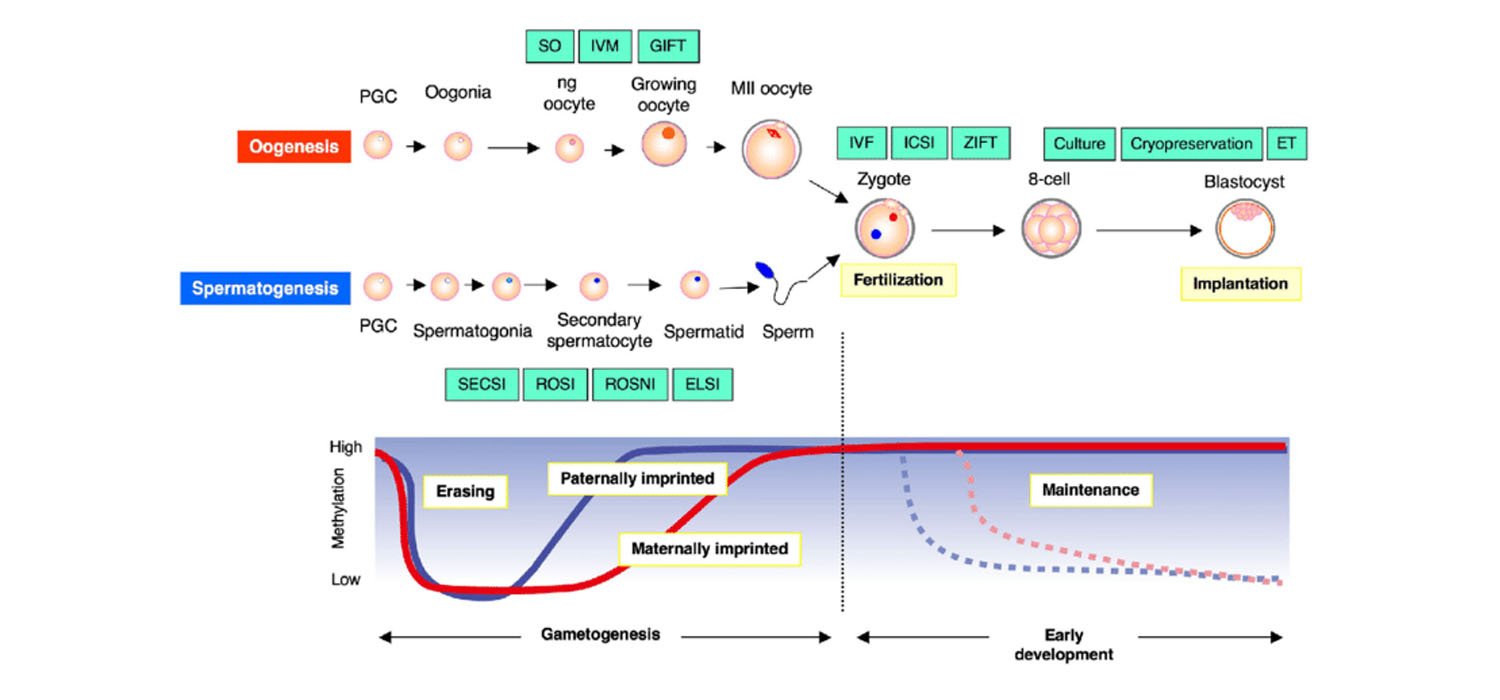Genomic imprinting
Genomic imprinting is a modification of the genome, selectively allowing genes from only one parental allele to be expressed.
The underlying mechanism is mostly epigenetic. That means the DNA sequence is not changed but the alleles are expressed in a different way. Alleles are stamped by epigenetic influences that continue throughout pre- and peri-implantation phases. Hence there is preferential suppression of one and expression of the other.
One percent of human genes are associated with imprinting. Many of them are associated with regulation of prenatal and post-natal growth.
In general, paternal disomy results in retarded growth of embryonic tissue but well developed extra embryonic tissue. Maternal disomy has well developed, normal or small embryos but retarded development of extra embryonic tissues.
Characteristics of genomic imprinting:
- It does not follow the Mendelian’s Law of Inheritance.
- Mechanisms are epigenetic.
- Gene for one parental allele is expressed.
- Genes are associated with growth regulation.
- Seen in placental animals.
- One percent of human genes are imprinted.
- Characterized by clustering- Genes prone for imprinting tend to cluster on certain chromosomes. These are domains of chromosomes 6,7,11,14, 15 and 20.
Clustering allows coordinated regulation of genes in a given chromosomal region. Two well-known imprinting clusters include Beckwith Weidman’s Syndrome (BWS)11p15. Angelman and Prader Willi syndrome on chromosome 15q11-q13. The clusters are regulated by imprinting centres (IC) which may be kilo-bases away.
The various conditions associated with imprinted genes include:
- Silver Russel syndrome ( 11p15/7p11-p13)
- Transient neonatal diabetes mellitus(6q24)
- McCune Albright Syndrome (20q13)
- Beckwith Weidman’s Syndrome (11p15)
- Angelman and Prader Willi syndrome (15q11-q13)
- Familial nonchromaffin paraganglioma (11q13)
- Maternal /Paternal UPD 14 syndromes
Is ART associated with increased incidence of Imprinting disorders?
There might appear to be fallacious increase in the incidence of imprinting disorders because of small sample size, no correction for maternal age or infertility and also statistical assumptions. More uniform studies are needed to confirm or refute this claim.
Potential risks in ART include:
- Infertility by itself.
- IVF- IVF related manipulations occur at the same period when epigenetic mechanisms are active in the germ cells. The epigenetic foci are remodeled principally during gametogenesis and early embryogenesis.
- Male gametes - Use of immature spermatids, surgically obtained germ cells, frozen-thawed gametes and ICSI manipulation of gametes have all been implicated . However, the erasure of old and acquisition of new imprints are completed at the spermatid stage of the sperm itself and these apprehensions may be unfounded.
- Female gametes - Ovulation induction, In vitro Maturation, super-ovulation, freeze-thawing injuries, culture, and micromanipulation of oocytes are some of the mechanisms being implicated.
- ICSI-Abnormal oocyte activation, disturbance of the oocyte cytoskeleton, leakage of cytoplasm, bypassing natural barrier and natural selection, removal of cumulus are some of the perceived aspects of concern.
- Embryo cultures - The temperature, pH, oxygen concentration, PGT have all been viewed with concern.
Prevention of epigenetic disorders
Protocols can be devised if the exact cause of imprinting disorders are known. Use of essential amino acids on the first three days can safe guard against imprinting. It is also vital to have strict control of the embryology environment.
For more info, Visit : www.medlineacademics.com
